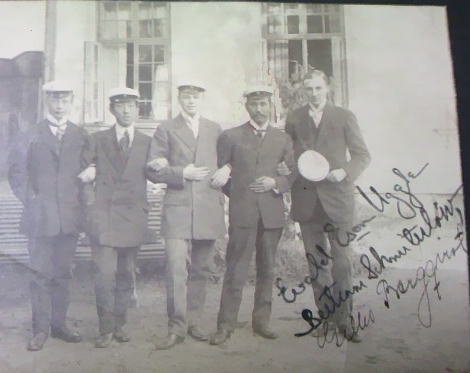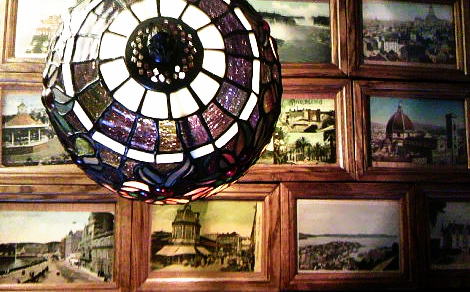お問合せ
事務局・工房くらし月
English top Concept Item list About us Contact

Photo:offered by Masaki's relatives
Professor Makoto Masaki (1874-1943)
is the second person to the right.
(The second person to the left is Viscount Narihide Ishikawa.)
Introduction
From 1910 to 1912, Makoto traveled with Viscount Ishikawa.
The aim of Makoto's trip was to study the school system in the
developed countries as well as to support Viscount Ishikawa..
**★☆***:*★☆***:*★☆***
Makoto was born in 1874 (Meiji 7) as eldest son of a farmer
in Saga Prefecture, Japan.
In 1872, the Japanese Government launched the modern school
system and also made an announcement of improving Japan's
calendar system by adopting the Gregorian calendar in order to
follow the developed countries, (In Japan December 3 in 1892
on the old calendar system was the same as January 1 in 1893
on the Gregorian calendar system.)
Makoto belonged to the first generation affected by Japan's many
symbolic changes to join the developed world. It is safe to say that
Makoto Masaki came from the first group of western-oriented Japan,
who made an outstanding achievement as a person.
************************
Postcards and the world trip of Professor Masaki
with Viscount Ishikawa:
They traveled the world for eighteen months on steamships, steam
locomotives, and using carriages. Picture postcards were sold
in the mainstreet corners where visitors stopped by. Those postcards
were hand-painted by artisans in black and white photography.
Color films did not circulate in those days.
Makoto bought those postcards and sent them to the family waiting
in Japan. Makoto returned to Japan with Viscount Ishikawa safely
in March 1912. It was the same year as the tragedy of theTitanic.

Photo:The Toki Museum
Postcards collected by Makoto Masaki during his world trip,
1910-1912.
*************************
The school system in Japan:
Firstly, elementary schools were started with Japan's modern
school system. Next, watching the situation, junior high schools
were started, and lastly, high schools were started. The influence
of hierarchy of social-class was still seen in those schools at first,
and the document for registration had a blank to be filled in with
to which social-class a student belonged, such as a "warrior family"
or a "common family".
Even under the new school system, only a small population of
children could receive higher education. For example, most children
from farmer families went to four-year elementary school at the
best, to learn basic skills in reading, writing, and calculating. After
they graduated from elementary school, eldest sons became
farmers, and other sons went to work as migrant workers.
Girls got married in their teens, being expected to give birth to boys.
There were children who could not even go to elementary school
because they had to take care of their younger siblings and do house
chores.
Makoto came from a rather rich farmer family, however, who was
originally doomed to be a farmer as eldest son after he graduated
from elementary school. There was a work ethic on a farmer's son
to begin working at an early age. Makoto's teacher (or teachers)
persuaded his family to keep Makoto studying, as he was outstanding
in academic work. Thanks to his teacher(s), he could go to Saga
Junior High School.
Scholarship of Marquis Naohiro Nabeshima:
As Makoto was the best student at Saga Junior High School,
he could get the scholarship from Marquis Naohiro Nabeshima,
who was the former feudal lord of Saga Prefecture. Then Makoto
entered the senior-secondary school in Kumamoto Prefecture,
and was enrolled in the best class. Makoto came from a farmer
family and actually was a "commoner", but when he entered this
school, his status was " a warrior family". Terusato Masaki,
an inventor known for the invention of noodle-making machine,
was Makoto's adoptive father in the admission document for the
school. This adoption was temporary, and Makoto returned to
the common status when he entered university.
From 1891 to 1894, the senior-secondary school in Kumamoto
Prefecture invited Lafcadio Hearn (1850-1904), a journalist
and writer, as an English teacher. Makoto seems to have taken
Hearn's class. Foreign teachers were well paid, so it is probable
that they have been preferentially assigned to the classes for
good students. As mentioned, Makoto belonged to the best class.
After Lafcadio Hearn left the school, his position as an English
teacher was taken over by Soseki Natsume, a famous Japanese
writer.
In 1894, the school changed its name to Kumamoto Fifth High School,
which later became Kumamoto University. When Makoto was enrolled
at the school, a senior-secondary school was equivalent to a modern
college.
Makoto graduated in 1894 and entered the Imperial University in
Tokyo. It was the only Imperial University in Japan until 1897,
when the second imperial university was established in Kyoto.
He got the scholarship from Marquis Nabeshima again.
Makoto graduated from Tokyo Imperial University and worked
at the prime minister's secretarial office for Shigenobu Okuma
from June in 1898 to November in the same year. After the
cabinet resigned in four months, Makoto studied at the graduate
school.
He became a teacher and got a job at Imperial Gakushuin.
After returning from the world trip from 1910 to 1912,
he worked as president of three normal schools.
He raised many teachers.
***************************
Conclusion:
Makoto was an elite who truly symbolizes the Meiji era. He was the
dream that Japanese people dreamed 100 years ago.
The top picture of this page was taken in Northern Europe in 1911.
Japanese people were rare there, and Masaki and Ishikawa had a
warm welcome by young nobles.
The picture above was taken as a happy memory.
*************************
copyright: 2019 the Toki Museum

Photo:offered by Masaki's relatives
Professor Makoto Masaki (1874-1943)
is the second person to the right.
(The second person to the left is Viscount Narihide Ishikawa.)
Introduction
From 1910 to 1912, Makoto traveled with Viscount Ishikawa.
The aim of Makoto's trip was to study the school system in the
developed countries as well as to support Viscount Ishikawa..
**★☆***:*★☆***:*★☆***
Makoto was born in 1874 (Meiji 7) as eldest son of a farmer
in Saga Prefecture, Japan.
In 1872, the Japanese Government launched the modern school
system and also made an announcement of improving Japan's
calendar system by adopting the Gregorian calendar in order to
follow the developed countries, (In Japan December 3 in 1892
on the old calendar system was the same as January 1 in 1893
on the Gregorian calendar system.)
Makoto belonged to the first generation affected by Japan's many
symbolic changes to join the developed world. It is safe to say that
Makoto Masaki came from the first group of western-oriented Japan,
who made an outstanding achievement as a person.
************************
Postcards and the world trip of Professor Masaki
with Viscount Ishikawa:
They traveled the world for eighteen months on steamships, steam
locomotives, and using carriages. Picture postcards were sold
in the mainstreet corners where visitors stopped by. Those postcards
were hand-painted by artisans in black and white photography.
Color films did not circulate in those days.
Makoto bought those postcards and sent them to the family waiting
in Japan. Makoto returned to Japan with Viscount Ishikawa safely
in March 1912. It was the same year as the tragedy of theTitanic.

Photo:The Toki Museum
Postcards collected by Makoto Masaki during his world trip,
1910-1912.
*************************
The school system in Japan:
Firstly, elementary schools were started with Japan's modern
school system. Next, watching the situation, junior high schools
were started, and lastly, high schools were started. The influence
of hierarchy of social-class was still seen in those schools at first,
and the document for registration had a blank to be filled in with
to which social-class a student belonged, such as a "warrior family"
or a "common family".
Even under the new school system, only a small population of
children could receive higher education. For example, most children
from farmer families went to four-year elementary school at the
best, to learn basic skills in reading, writing, and calculating. After
they graduated from elementary school, eldest sons became
farmers, and other sons went to work as migrant workers.
Girls got married in their teens, being expected to give birth to boys.
There were children who could not even go to elementary school
because they had to take care of their younger siblings and do house
chores.
Makoto came from a rather rich farmer family, however, who was
originally doomed to be a farmer as eldest son after he graduated
from elementary school. There was a work ethic on a farmer's son
to begin working at an early age. Makoto's teacher (or teachers)
persuaded his family to keep Makoto studying, as he was outstanding
in academic work. Thanks to his teacher(s), he could go to Saga
Junior High School.
Scholarship of Marquis Naohiro Nabeshima:
As Makoto was the best student at Saga Junior High School,
he could get the scholarship from Marquis Naohiro Nabeshima,
who was the former feudal lord of Saga Prefecture. Then Makoto
entered the senior-secondary school in Kumamoto Prefecture,
and was enrolled in the best class. Makoto came from a farmer
family and actually was a "commoner", but when he entered this
school, his status was " a warrior family". Terusato Masaki,
an inventor known for the invention of noodle-making machine,
was Makoto's adoptive father in the admission document for the
school. This adoption was temporary, and Makoto returned to
the common status when he entered university.
From 1891 to 1894, the senior-secondary school in Kumamoto
Prefecture invited Lafcadio Hearn (1850-1904), a journalist
and writer, as an English teacher. Makoto seems to have taken
Hearn's class. Foreign teachers were well paid, so it is probable
that they have been preferentially assigned to the classes for
good students. As mentioned, Makoto belonged to the best class.
After Lafcadio Hearn left the school, his position as an English
teacher was taken over by Soseki Natsume, a famous Japanese
writer.
In 1894, the school changed its name to Kumamoto Fifth High School,
which later became Kumamoto University. When Makoto was enrolled
at the school, a senior-secondary school was equivalent to a modern
college.
Makoto graduated in 1894 and entered the Imperial University in
Tokyo. It was the only Imperial University in Japan until 1897,
when the second imperial university was established in Kyoto.
He got the scholarship from Marquis Nabeshima again.
Makoto graduated from Tokyo Imperial University and worked
at the prime minister's secretarial office for Shigenobu Okuma
from June in 1898 to November in the same year. After the
cabinet resigned in four months, Makoto studied at the graduate
school.
He became a teacher and got a job at Imperial Gakushuin.
After returning from the world trip from 1910 to 1912,
he worked as president of three normal schools.
He raised many teachers.
***************************
Conclusion:
Makoto was an elite who truly symbolizes the Meiji era. He was the
dream that Japanese people dreamed 100 years ago.
The top picture of this page was taken in Northern Europe in 1911.
Japanese people were rare there, and Masaki and Ishikawa had a
warm welcome by young nobles.
The picture above was taken as a happy memory.
*************************
copyright: 2019 the Toki Museum
バナースペース
shop infoTHE TOKI MUSEUM
THE
TOKI
MUSEUM
PRIVACY POLICY
FACEBOOK
TWITTER
BLOG
JAPANESE
The Toki Museum